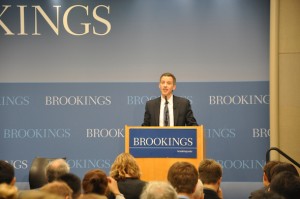WASHINGTON — U.S. Federal Reserve Board Gov. Jeremy Stein defended the Fed’s recently announced policy of the third round mortgage-backed security purchases and restated its priority is to lower the unemployment rate and boost the U.S. economy.
Stein spoke Thursday at the Brookings Institution and said the theory behind large-scale asset purchases — LSAPs — an unconventional tool that Federal Open Market Committee decided to use to further promote the U.S. economic activities. The policy is also called quantitative easing.
“To be clear on where I stand, I support the committee’s decision of last month,” Stein said. “Given where we are and what we know, I firmly believe that this decision was the right one.”
Stein pointed out Fed’s dual mandate is the point of departure for any analysis of monetary policy — “to foster maximum employment and price stability.”
“Unemployment remains painfully high and, in my opinion, well above the long-run structural rate of unemployment,” he said.
“Moreover, smoothing through the ups and downs of incoming data, it appears that the economy is growing at a pace such that, absent policy action, progress on reducing unemployment will likely be slow for some time.”
When asked how to respond to the widespread concern that inflation might be caused by the Fed’s policy, Stein showed strong disagreement.
“I understand the economic logic and how the model works … In my view, it’s just not right. I just disagree fundamentally with that,” Stein said during the discussion led by Donald Kohn, senior fellow at the Brookings Institution.
Stein said in the speech that “inflation is subdued, running at or below our long-run objective of 2 percent, while inflation expectations remain well-anchored.”
Other economists appear to agree with Stein on this point.
“We still have a long way to inflation. The economy is still too sluggish to worry about inflation right now,” said Brian Jones, a senior U.S. economist at Societe Generale in New York. “I think (Quantitative Easing 3) is absolutely the right decision to make.”
“I think there is no near-term for inflation but Fed is laying groundwork for inflation,” said David Sloan, a senior economist at 4cast Inc. in New York. “Also we’ve got fiscal cliff coming up. So QE3 will be offset from the fiscal side. We all know that fiscal cliff might bring U.S. economy back to recession.”
Another issue raised during the conference was the policy’s possible repercussions on the rest of the world. Stein said there is no “corresponding effect.”
“One of the things that Federal Reserve and other central banks can do that’s positive for the other countries is to raise growth,” Stein said.
The Federal Open Market Committee decided during its September meeting to increase policy accommodation by purchasing additional agency mortgage-backed securities at a pace of $40 billion per month, also known as the third round of quantitative easing. The committee also decided to keep the target range for the federal funds rate at 0 to 0.25 percent and extend the low rate at least through mid-2015.
“I am hopeful that these actions by the Federal Reserve will help to give economic growth a much needed boost,” Stein said. “At the same time, I am keenly aware of the many uncertainties we still have about the workings of nonconventional policies, and of LSAPs in particular.”
The U.S. unemployment rate in September dropped to 7.8 percent, marking the first time that figure has been less than 8 percent since January 2009. The second quarter gross domestic product, however, fell to 1.3 percent from 2 percent in the first quarter this year.
“There have been a lot of improvements in September. But these numbers are volatile and maybe inaccurate,” Sloan said. “I think the September unemployment rate exaggerated the improvement in the labor market.
“There should be more QE measures in the early 2013. The ease will be even more aggressive than it is now.”

